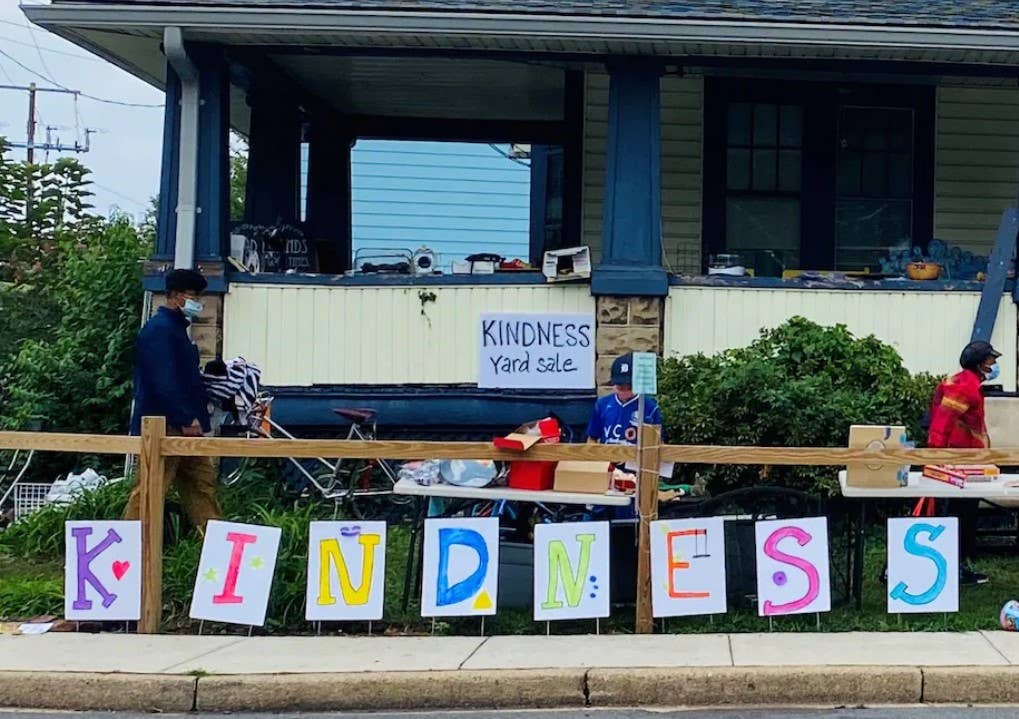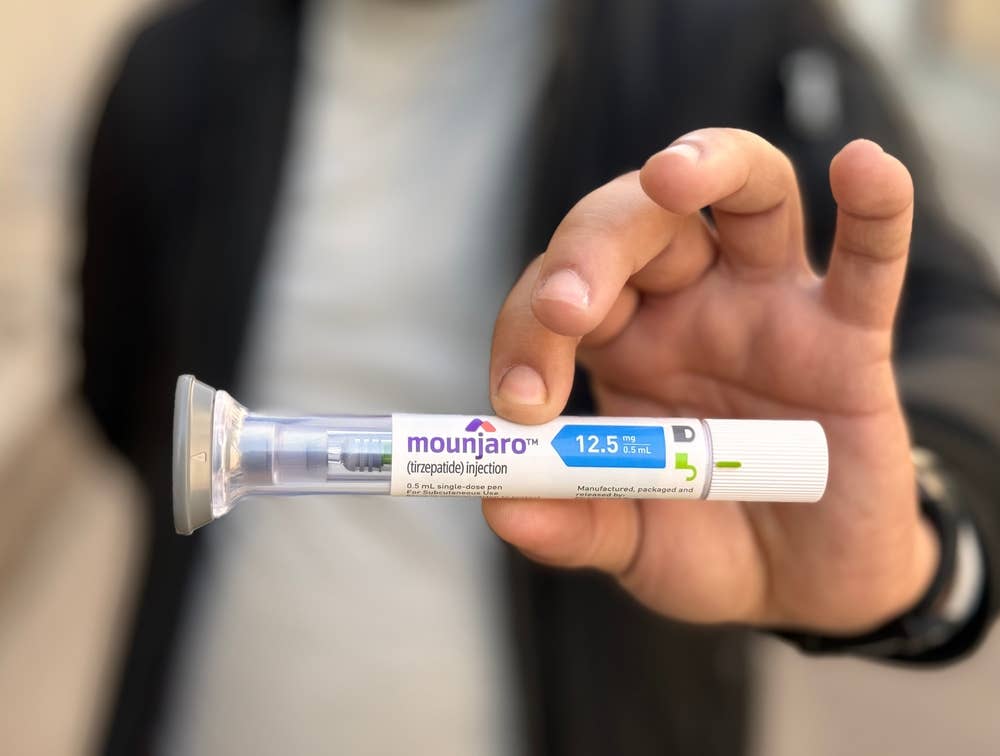How a 2-day ‘Kindness Yard Sale’ turned into a year’s worth of kindness
There’s no judgment or side-eye here in Thompson-Gaines’s yard. There is just “Thanks” and “Have a nice day” and “Hope you enjoy that.”

[Sept 26, 2021: Theresa Vargas]
Susan Thompson-Gaines holds a “Kindness Yard Sale” outside her Arlington home. (CREDIT: Theresa Vargas/The Washington Post)
It’s not hard to spot Susan Thompson-Gaines’s house on a recent afternoon in Arlington.
A teddy bear larger than a man sits on her porch, and her yard is packed with people picking through items of all sorts — useful items, unusual items, items that make people ask: “What’s this?”
There are shelves of books, racks of clothes and tables topped with toys. There’s a guitar with three strings and a vintage Fisher-Price record player. There’s a cicada preserved in a pyramid of resin.
And all of it is for sale, for whatever price you want to pay (or bid, if you’re eyeing one of the few items up for auction). You decide the items’ worth.
If you want to give $5 for 20 dresses, that’s fine.
If you want to hand over $10 for a bike, that’s great.
There’s no judgment or side-eye here in Thompson-Gaines’s yard. There is just “Thanks” and “Have a nice day” and “Hope you enjoy that.”
This is what it feels like to attend the “Kindness Yard Sale.”
A box at the yard sale asks people to submit ideas for how the funds should be spent. (CREDIT: Theresa Vargas/The Washington Post)
The annual event, which took place over the weekend, is unusual in how it came to be and what will come of it: enough acts of kindness to fill a year. Most of those acts will take place in the Washington region and come in the form of surprises to people who have specific needs and people who are simply having a hard day.
Consider what happened after last year’s yard sale outside Thompson-Gaines’s Northern Virginia house.
The funds went toward buying camping gear for a boy who had never left the city, throwing a virtual beach party for a group of people living with Alzheimer’s disease, and keeping an outdoor pantry filled with food.
They went toward buying a fetal Doppler for a pregnant woman whose husband couldn’t hear their child’s heartbeat at the hospital because of coronavirus restrictions, paying a woman’s DMV fees while she tried to get through the process of transferring the car title of her deceased father into her name, and adding coffee pods to a teacher’s lounge.
They went toward helping Thompson-Gaines play Santa for a bunch of neighborhood children.
For that, she and her husband, David, set up an outdoor station for kids to write letters to Santa. The instructions asked the children to list a few small items they wanted and a parent’s contact information. Thompson-Gaines then wrote each child, all 111 of them, a personalized letter from Santa, purchased each a gift and left it wrapped under a tree that was adorned with ornaments from people across the neighborhood.
“It was so fun,” she says when we talk. “I’m hoping we’ll be able to repeat that this year. And I know the kids in the neighborhood are counting on it.”
Growing up, many of us were taught that acts of kindness should be done quietly and anonymously, that to talk about doing something nice for someone else takes away from the goodness of the deed. Thompson-Gaines believes otherwise. She thinks people should talk more openly about kindness, and that doing so creates “kindness ripples” that spread from one person to another.
She sees kindness as a form of activism — as a purposeful push to create change — and describes herself as a “kindness activist.”
“I am a vigorous advocate of KINDNESS!” she writes on a blog where she details how the yard sale funds are spent. “I hunt for it. I appreciate it. And, whenever I can, I SPREAD IT!”
Thompson-Gaines has, in a way, created an interesting experiment in her neighborhood centered around an important question: What happens when someone makes an effort to show kindness to others, and then shares the stories about those interactions? The answer, so far, based on what’s happened at the yard sale, seems to be that it causes more people to want to help others.
I had heard about Thompson-Gaines, who works as an ASL interpreter, before I met her. People talk excitedly about her work on neighborhood social media pages, and one person emailed me about her. I brought my younger son with me to her yard sale and, among the masked shoppers, we met a boy who had spent the day before helping to haul clothes for the event. We learned that neighbors had translated the pay-what-you-want concept into 20 languages in case non-English speakers didn’t understand why nothing had a price tag. And we saw a sidewalk-facing pantry that not only had food but also offered a place for people to put in special requests.
Thompson-Gaines says the yard sale has evolved since she started it three years ago. That first year saw her working mostly alone, asking her neighbors to donate items, picking them up and arranging them outside her home. Now, the event has become a communal effort for the neighborhood, leaving her with no shortage of helpers or donations.
“This year, it was just like an army of people saying, ‘I’m here, what do you need?’ ” she says. She has also noticed that many people now use the collective “we” when talking about the event. “People will say, ‘How did we do today?’ It’s become a community thing, which I love.”
People dug through toy boxes, their kitchen shelves and garages to find things to donate to the cause. Some even brought items that were hard to let go of.
One day, Thompson-Gaines opened her front door to find a woman standing on her porch with an armful of clothes.
The woman explained that her mother had died of covid-19 and she was now preparing to move her father into a nursing home. She needed to clean out their house, which meant dealing with her mother’s clothes.
She told Thompson-Gaines that she wanted them to go to the yard sale. That way, she explained, she would know something good came of them.
“She was the first stranger I hugged since covid,” recalls Thompson-Gaines, who also lost her parents and shared that with the woman. “We were both crying.”
After the first yard sale, when Thompson-Gaines added up the money that was collected, she had $1,705 to spend on acts of kindness. After this one, even with all the calculations not yet complete, the yard sale raised more than $11,000. Someone bid $230 in an auction for the giant teddy bear. Another person paid $75 for that resin-encased cicada.
Thompson-Gaines says she hopes to one day get a storage unit so she can collect items all year (instead of just over three weeks) and have a place to put unsold things. For now, it takes her days to clear her yard and find new homes for the items that aren’t small enough to store easily.
On Monday, a day after the yard sale ended, she was sleeping when a group of women walked into her yard to look through the clothes that remained outside. Her husband went out to greet them and they bought a few pieces of clothing.
Thompson-Gaines later learned that a neighbor had directed the women to her house and explained to them in Spanish that they could pay whatever they wanted.
They could do that, he told them, because that’s where “Señora Santa” lives.
For more good news stories check out our Good News section at The Brighter Side of News.
Like these kind of feel good stories? Get the Brighter Side of News' newsletter.
Tags: #Good_News, #Yard_Sale, #Kindness, #Community, #Generosity, #Helping_Hand, #The_Brighter_Side_of_News



